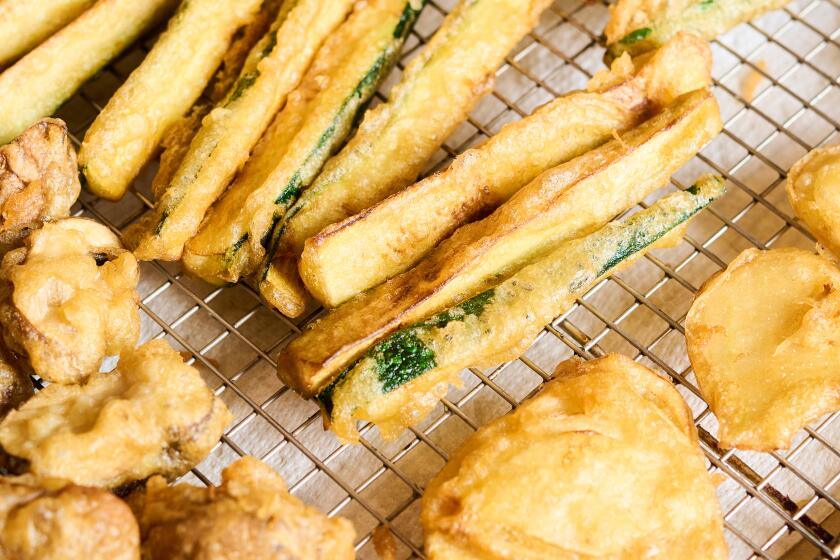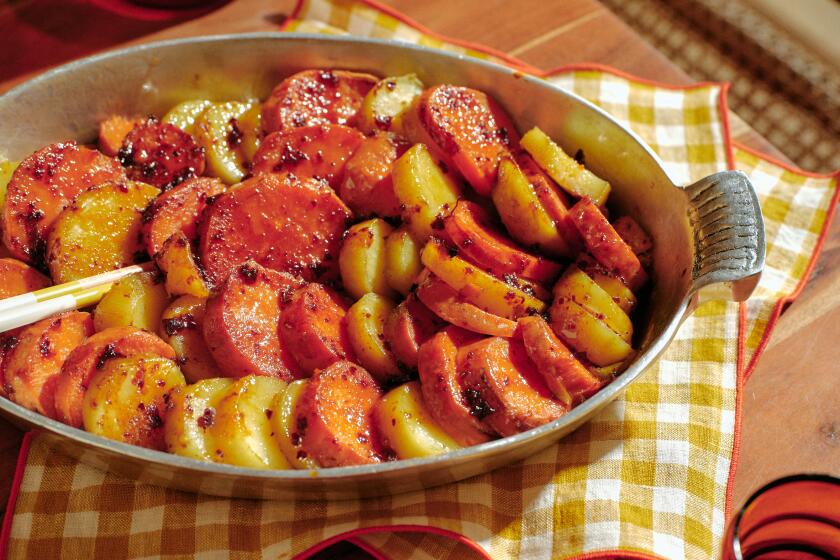Chives stir-fried with bean sprouts (Ching chau sub choi)
Eileen Yin-Fei Lo’s new “My Grandmother’s Chinese Kitchen: 100 Family Recipes and Life Lessons” is a beautiful book.
As an object, it’s charming, though not in a coffee-table or chef-opus way. The only photographs inside are a few of the author’s black-and-white family pictures -- no glossy food porn.
The size and thickness of a good novel, it’s appealingly designed. A transparent parchment dust jacket with pretty dark red ornaments and border encloses the cover, which has a collage of what looks to be family photographs and a line of Chinese characters in red.
It’s so nice to hold in your hands that I might have bought it even if I didn’t know the reputation of Lo, the award-winning author of nine other cookbooks, including “The Chinese Kitchen” (1999).
The book’s concept, to one uninitiated in the ways of the wok, is irresistible: Lo tells us the story of how her grandmother, whom she called “Ah Paw,” taught her to cook, beginning with “perfect cooked rice” (fan), then progressing through such basics as chicken stock, scallion oil, salted pork and a fried rice dish she calls “leftover rice.”
I started from the beginning, and that meant buying a wok (an inexpensive, 14-inch, carbon-steel number with a flat bottom) and a lid and seasoning the wok.
And as I flipped through the book, seeking recipes to test, I started reading, and therein lies the book’s real beauty: Lo’s writing is wonderful, and her stories are engaging, whether she’s telling about why her male cousin’s nickname was “Baby Girl” or about her mother, at age 10, refusing to keep her feet bound.
Lo’s grandmother had bound feet and, thus, never strayed far from her kitchen in the Guandong district of Sun Tak, a suburb of Guangzhou (Canton), the kitchen from which she dispensed to the author so much wisdom of every kind.
“She suggested to me,” Lo writes, “that vegetables should be chosen with at least the same care given to selecting in-laws, and that no vegetable should be eaten if it had been out of the ground for more than two hours. She warned me that for every uneaten rice kernel I left in my rice bowl my future husband would have a pock on his face. Meats were to be cut into perfectly matching lengths and widths as Confucius had directed.”
Clearly, I was in good hands. I prepared salted pork, simmering a boneless pork loin in water for about an hour with ginger, garlic and scallions, then pulling it out, rubbing it with salt and leaving it to rest in the fridge for one day. It turns out to be a wonderful thing to have on hand as an ingredient, a fact not lost on Lo.
I used the salted pork, along with easily prepared scallion oil, to make the leftover rice, and then a silken bean curd stir-fry with scallions and hot bean sauce. Slices of the pork even went between slices of Dijon-smeared baguette and into my 10-year-old’s lunchbox.
I also tried Lo’s recipes for won ton and for steamed bass with ginger, cilantro and scallions, as well as for shrimp stir-fried in bean sauce and chives stir-fried with bean sprouts. The last is a wonderful dish that’s called ching chao sub choi, which, according to Lo, translates literally as “lightly stir-fried 10 vegetables.”
“The word chives,” she writes, “is gau choi, which means ‘nine vegetables.’ Thus nine vegetables plus bean sprouts equals ten.”
The recipes -- almost all of them -- were problematic, though, oddly, it didn’t seem to matter. Many are unclear. I had to guess, for instance, whether the simmered pork loin is meant to be dried off before salt is rubbed into it. I guessed yes. A recipe for scallion pancakes makes no mention of whether the Chinese bacon and Chinese sausage (lop cheung) need to be precooked. (According to the instructions on every package of lop cheung I could find, yes.)
Should the crepe pan or nonstick fry pan for the pancakes be heated over high heat? Medium? The recipe doesn’t say. A recipe for pan-fried noodles with shredded pork calls for 6 ounces lean pork, shredded. Is the pork raw? If so, how does one shred raw pork? Is it cooked? If so, how? The recipe doesn’t say.
Other recipes have cooking times that are off and one for Chinese broccoli is missing listings of key ingredients -- kau yuk, untranslated, suddenly appears in an instruction along with “sauce.”
Egad! One can only surmise that no one has backed up the author with appropriate recipe testing and editing. (Of course, we test all recipes we publish in The Times, so those printed here have been adjusted and adapted for clarity.)
But here’s the remarkable thing: Just about every dish I made from the book, plus three that The Times test kitchen prepared, turned out to be terrific. All the food was so great -- such fresh, clear flavors, such wonderful textures and all of it so much fun to cook -- that I wound up cooking nothing but dishes from this book for the better part of two weeks. Either I guessed right every time or, as with “grandmother cooking” around the world, precision isn’t really required.
And the “perfect cooked rice”? OK, I had to tweak it a little. But I’ll forever use Lo’s Ah Paw’s basic method.
One hour before you’d like to stir-fry, bring 4 cups of water to a boil in a large pot. Add the bean sprouts and stir for 10 seconds. Turn off the heat, run cold water into the pot and drain. Boil and drain the sprouts a second time, then lay the sprouts out on a board to dry, loosening them with chopsticks occasionally to help the drying.
Heat a wok over high heat for 1 minute. Add peanut oil and coat the wok, using a spatula. When a wisp of white smoke appears, add the ginger and stir. When the ginger turns light brown, add the chives and fry, stirring well, for about 30 seconds or until the chives turn bright green. Add the bean sprouts, stir well, and cook for 1 minute. Turn off the heat, add the salt and toss well to season. Transfer to a heated dish and serve immediately.
Get our Cooking newsletter.
Your roundup of inspiring recipes and kitchen tricks.
You may occasionally receive promotional content from the Los Angeles Times.















